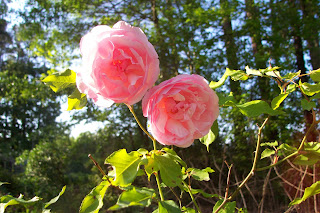This week I wanted to talk about a less well-known class of roses called "Portland". (It's one of those cute factoids that Portland, Oregon, is famous for it's rose gardens and the fantastic Portland Rose Festival .) Anyway, this is about the historic class of Old Garden Roses, dubbed "Portland".
The Portland class of roses was one of the first to combine the European
roses with newly imported, repeat-blooming China roses that were brought to England in the late 18th/early 19th century by English explorers of China. The first member of the Portland class was recognized as such around 1800 in
the gardens of the Duchess of Portland.
Details about the origins of this
first Portland are sketchy, but it does appear
that the Duchess may have originally obtained the rose, Rosa paestana, i.e. ‘Scarlet Four Seasons’ Rose’ from Italy . This rose was eventually sent from England to André Dupont, the Empress Josèphine’s
gardener in France ,
where he named the rose ‘Duchess of Portland”.
The French then raised numerous varieties, crossing them with other
classes such as Chinas.
Theories abound about precisely
which roses were involved in the creation of this class, although most sources
cite some combination of Gallica, Damask, Centifolia and China . David Austin believes he recognizes Damask in
the ancestry as well as China ,
and speculates that ‘Slater’s Crimson China’ may have been thrown into bed with
a French Gallica rose at one point or another.
Although Portlands were only
really popular for a brief period in the early years of the 19th
century before Bourbon and Hybrid Perpetuals overshadowed them, they are still
excellent garden additions.
The Portland class is a small group of roses,
only a few dozen were hybridized during the 19th century and none in
the 20th or 21st.
They are very winter hardy, however, and are very strong rebloomers.
Most Portlands show some of the
same characteristics as the Damasks, except they are generally shorter. And of course, unlike Damasks, Portlands
rebloom.
Characteristics include:
v Moderate size, most are around 4’ tall, making them good
garden additions where there is not a lot of room.
v The flowers have very short stems with leaves growing
around the flower. Graham Thomas
describes this as a rosette or shoulder of leaves.
v Flowers repeat fairly reliably.
v Portlands have a rich, strong Damask rose fragrance.
v Disease resistance is quite good.
Some good varieties include:
v ‘Comte de
Chambord’, introduced 1860 by
Moreau-Robert (France ). An extremely popular rose, even today. The flowers are very full, quartered, in a
clear pink with an extremely powerful Damask rose fragrance. This is a strong grower and forms an upright
shrub around 4’ tall with lots of foliage.
Repeat flowering.
v ‘Indigo’, circa
1830. Forms a compact bush around 4’
tall with dark green foliage. The
flowers are large, with a lovely dark purple hue.
v ‘Rose de Rescht’ was brought to England
by Miss Nancy Lindsay from Iran
or France . This rose forms a bushy shrub that stays
fairly small, approximately 3’ tall.
Very double flowers have a purplish-crimson color and are fragrant. There is ample, rough-textured foliage, and
it reliably produces at least two crops of flowers.
v ‘Marbrée’ was raised by Robert et Moreau in 1858, in France . The shrubs tend to grow to about 4’ tall with
plentiful dark green foliage. The
flowers are a deep purple-pink, mottled with pale pink. They open flat and have only a slight
fragrance. These roses are generally
free of disease.
v ‘The Portland
A Rose Before Dying
Only Sir Edward had the
motive and the opportunity.
When the first
victim dies, Sir Edward is the likeliest culprit. The murdered woman was Sir
Edward’s ex-mistress who threw him over for a younger man, and she dies after
receiving a mysterious rose. Confused and stricken by her death, Sir Edward is
horrified when a second rose is delivered, along with a note insinuating that
he had something to do with his mistress’ death. In desperation, he begs his
nephew, Charles Vance, to help him prove his innocence.
Charles Vance,
the new Earl of Castlemoor, is convinced Sir Edward is innocent and agrees to
work with the renowned head of the Second
Sons Inquiry Agency to flush out the murderer. But the investigation soon
reveals more reasons why Sir Edward may be responsible and even the inquiry
agent warns Charles not to let family loyalty stand in the way of the truth. There
may be some truth behind the rumors. "The
roses may simply be Sir Edward’s attempt to cast suspicion elsewhere."
"Misdirection." Or so the whispers say.
Desperate to
stop the murders, Charles enlists the aide of notable rosarian, Ariadne
Wellfleet, to identify the roses in hopes of saving the next victim.
Unfortunately, his actions sweep the Wellfleet household into the killer’s net
and puts friends and family alike at risk. He has no choice but to finish the
investigation, regardless of the costs.
A Rose Before Dying is a witty
Regency whodunit combined with a heart-warming romance in the tradition of Georgette
Heyer’s The Masqueraders and Victoria
Holt’s The Mistress of Mellyn. This
addition to the Second Sons mystery series includes an unwilling detective whose
family loyalties are tested as he seeks to catch an elusive killer.









